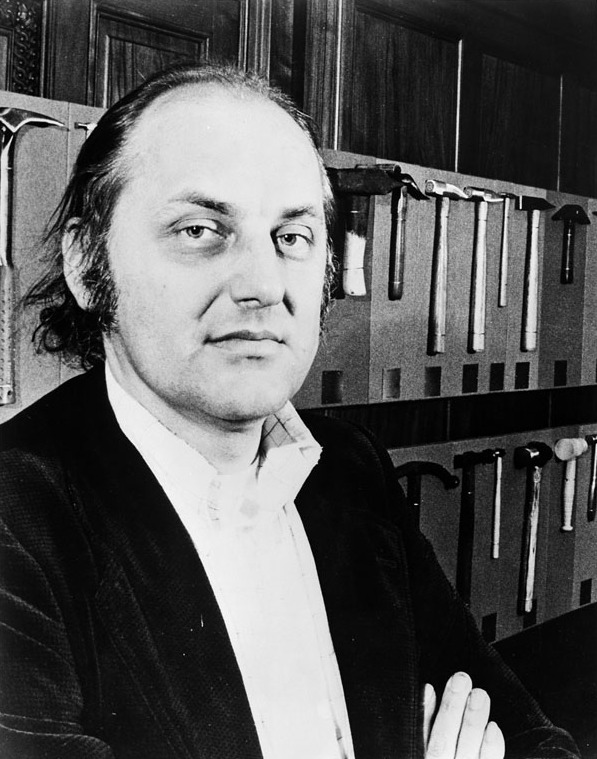Was born in Vienna
1934 - 2014
Hans Hollein

description
Hans Hollein (1934 – 2014) – Austrian architect, artist, designer, winner of the Pritzker Prize (1985), one of the leaders of European postmodernism, who proved himself as a master of a small unique form and expressive details. He considered architecture and art to be inseparable, and himself an artist. In its architecture features of neohistoricism, slick-tech, lendform architecture are visible. His style is very metaphorical. Considering architecture as a system of signs and a communication medium, he developed a collage and citation approach that would allow a new spirituality to emerge. In his work, there is a noticeable desire to return to the old-fashioned monumentality to release the magical, symbolic and poetic potential of archetypal forms.
Key ideas of his work:
A designer, philosopher, theorist, he called architecture “body temperature control”, “protective casing” and “mental conditioning”. Whatever Hollein designs, his things have their own face, which will be remembered for a lifetime.
According to him, unlike the usual addition of tectonic forms, construction by subtraction gives more freedom, plasticity, a complex spatial concept and an expansion of real volume. Therefore, Hans Hollein’s architecture, like any postmodernist, is quite syncretic – it is very difficult to draw a line between different types of art in it. His early works were solutions in the field of creating a minimal environment, taking into account the human body, temperature, insulation and its movement in its own space. Historical self-reflection occupied an important place in his work. He loved to display forms and materials from different periods and cultures, interpreting them in accordance with postmodern aesthetics. His shape does not follow function. He proposed a return to architecture as an art form – “architecture without a purpose”. What we build will find its usefulness. In each of Hans Hollein’s transformations, the object becomes monumental and visually dominates the space in which it is located.
Main structures:
- Retti Candle Shop, (1966) Austria, Vienna;
- Jewelry store Schullin, (1974) Austria, Vienna;
- Museum of Glass and Ceramics, (1978) Iran, Tehran;
- Museum Abteiberg, (1982) Germany, Mönchengladbach;
- Shopping center Haas-Haus (1990) Austria, Vienna;
- Museum of Contemporary Art (1991) Germany, Frankfurt am Main;
- Embassy of Austria (2001), Germany, Berlin;
- Vulcania – European Center for Volcanology (2002), France, Saint-Urs;
- Titanium canopy “Wing of Soravia” over the entrance to the palace of Archduke Albrecht (2003), Austria, Vienna;
- Rothschild Castle. Reconstruction (2005) Austria, Waidhofen an der Ybbs;
- House Generali – penthouse (2005), Austria, Vienna;
- Skyscraper SBF (2018) China, Shenzhen.
Hans Hollein’s postmodernism in the architecture of Vienna and other cities. In his early work, Hans was one of the leaders of postmodernism, worked with small shapes.
1934
1956
1958 - 1959
1960
1964
1985
Was born in Vienna
Graduated from the Vienna Academy of Arts
Graduated from the Vienna Academy of Arts
Studied at the Illinois Institute of Technology
Studied at the Illinois Institute of Technology
Studied at the University of California at Berkeley
Studied at the University of California at Berkeley
Foundation of his own office in Vienna
Foundation of his own office in Vienna
Won the Pritzker Prize
Won the Pritzker Prize.
description
Hans Hollein continues the theme of historical citation in the creation of one of the facades "Strada Novissima" for the Venice Architecture Biennale in Venice (1980), the slogan of which was, "The presence of the past". Hollein's façade was a vivid metaphor for the past, perceived through the worldview of postmodern irony. The architect chooses the most widespread art-compositional system in the entire history of architecture - the order system.
1980
description
Hans Hollein uses historicized forms to which he provides a metaphorical character. The interior space is designed as a theatrical performance - an imitation of pyramids, mountains, tents, palm trees, symbolizes tourism. Each item in this installation is an allusion and reference to something.
